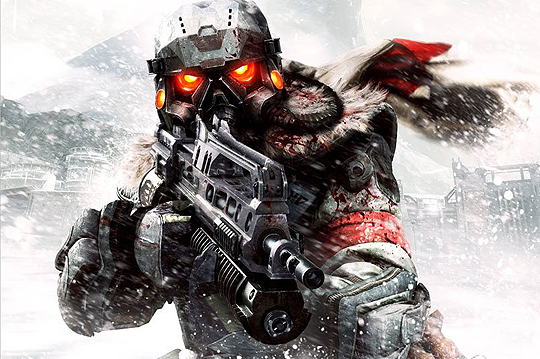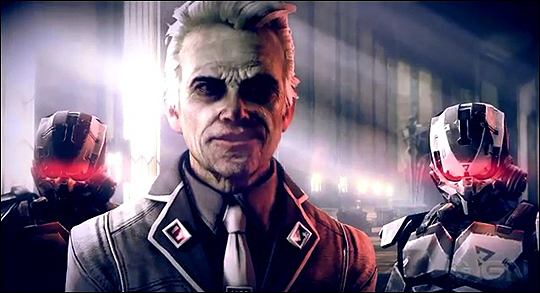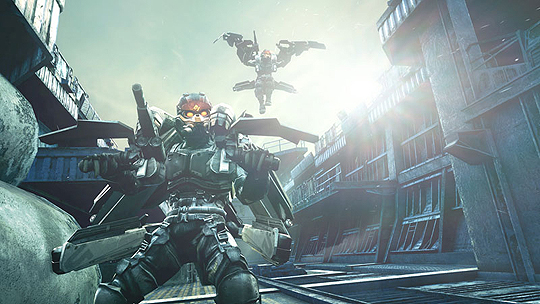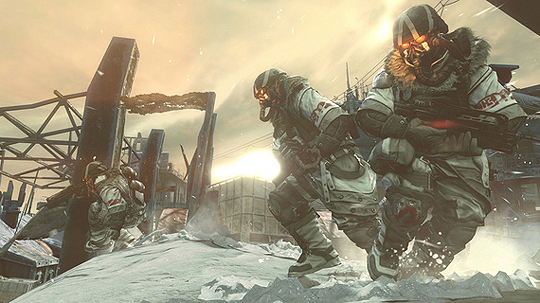
Killzone 3 is like a Michael Bay film. The high-concept premise sounds awesome, but that’s where the entertainment factor pretty much stops. Things like warring transforming robots sound amazing when distilled to one sentence, but the execution in such productions amounts to endless clichés and lots and lots of people jumping away from explosions, preferably in slow motion. Killzone 3, much like a Michael Bay movie, also looks absolutely gorgeous in a clearly digitized way.
Killzone 3 takes place on a distant future world where humans of the past split in two due to political disagreements, and all the republicans went to live on planet Helghast. After a few centuries, the Helghastians evolve (literally) into a powerful and very angry force, bent on defeating the ISA (the good guys) no matter what it takes. A very cool premise (much like giant, battling, transforming robots) that ultimately delivers a sometimes laughable set of impossible circumstances and unnecessary explosions (much like giant, battling, transforming robots).
When it comes to Killzone 3, though, that is why you are willing to pay the ticket price. It’s not about asking why on Earth a poorly guarded room would contain secret and easily accessible evil plans, or wondering how someone could possibly survive clearly fatal vehicle crashes, it’s about pointing out how absolutely stunning everything looks, and Killzone 3 pulls this off with very little effort.

Everything in Killzone 3 looks great, and not even from a strictly technical perspective. The team over at Geurrilla games is great at crafting recognizable character, vehicle, weapon, enemy, and everything-else designs. Every piece of the world has been conceptualized brilliantly and everything looks great. The world of Helghast, where the game takes place, feels like a real place, albeit one you would never ever want to visit under any circumstances, and the way the Helghast soldiers use their bodies to intercept your oncoming bullets is like a beautiful symphony of violence. They should have sent a poet instead of soldier, just so they could write about the way geysers of blood eject from every bullet wound. I really can’t do the visuals justice.
Therein lies the problem with Killzone 3. Its focus on visuals makes the game look ahead of its time, but the level design, gameplay progression, and narrative delivery feel dated. There is no reason to explore any facet of a level other than to figure out where the next crouch point is, and the almost complete lack of fluid storytelling makes the narrative feel stilted and oddly displaced. Just about every instance where a new section or cutscene is ready to play, the game fades to black, very quickly pulling the player from the game. Many of these fade to black scenes occur during sequences that play consecutively. In fact, very rarely throughout the entire game does the narrative move aside from a continuous story. It may seem like a middling complaint (and it is a bit, to be honest), but some consistency in the storytelling perspective would have helped the pacing tremendously. It’s as though Guerilla games has never even heard of Half-Life.
There were also issues with the sound. Voice acting is passable for the most part, with the exception of Malcolm McDowell as Jordan Stahl, who is one of the game’s character highlights, in both voice and design. Out on the field though, I would run into problems with voices not syncing correctly with cutscenes, and explosions somehow missing their desired impact. All the music and sound certainly got the job done, but it really felt incomplete at times.

The real question though, is how is the shooting? To answer briefly, It feels a lot like Killzone 2. The jump in gameplay between Killzone 2 and 3 is only a small hop, but that’s okay, because the shooting has always had a good visceral feeling to it, so there was little need to upgrade much. It differs from other shooters thanks to its cover mechanics, which work very well. The L2 button is less of a crouch, and more of a duck button, locking you in place behind cover. Peaking out is simple and quick, and it is where the game feels the best. Once you are on foot firing from the hip at the Helghast who are not behind cover, it is pretty apparent that that is not way the game is supposed to be played. Those run and gun scenarios though, are rare.
The addition of Move controls was one I was not very keen on, but after spending a number of levels with the device, I have to say that I am impressed. I would even go so far as to claim no preference between the two control types. The majority of the game is played from behind the cover of a short wall, and in this situation, the Move controller works really well. Your foot movement is limited, so all you have to do is aim, and aiming with the on-screen Move cursor works very well. You are even given a little help with the Move in that pulling up your sight will lock onto the enemy you are aiming for. Once you get up on your feet and start moving around, though, the Move does not feel quite as solid, but it’s a worthy trade for the excellent aim.
You can use the buttons on the Move controller to perform actions like reload, etc., but even these feel better when you use the motion options. Reloading is done by rotating the Move controller like a key. The main point of reference for motion-controlled shooters is the Wii, and reload has historically required a rough shake of the Wii remote or nunchuk. When you do this, you quickly lose your cursor on screen, thanks to the violent shaking. By twisting the Move to reload, you are left with your aiming cursor relatively stationary. It works well, and I never ran into a situation where I got frustrated, which is a huge win for motion control. Many will stick with the DualShock 3 simply for the sake of familiarity, which is totally understandable, but know that the Move does offer a different, working play style. It is one that is a lot of fun, while feeling different than what you are used to.

Along with the substantial single-player experience, you can also play through the game locally with split-screen co-op, and play with bots in the same gametypes as are available online. Bots are a dying feature when it comes to shooters, and it was one I was glad to see available in Killzone 3. The lack of online co-op was more puzzling than disappointing, but it’s hard to complain about extra features, even if the features themselves aren’t fully featured.
Online multiplayer makes up a large portion of the Killzone 3 experience, and it sets itself apart from other online shooters with the option to choose a distinct class. There are five different classes to choose from. The engineer can fix damaged machinery and set turrets. The field medic can provide aid by reviving knocked out teammates. The infiltrator and the marksman are somewhat similar, in that they both work in deception. The infiltrator can use a costume and the marksman can cloak itself. The tactician is the last available class, and can create spawn areas in the level. The classes don’t feel dramatically different from one another, but are different enough to allow for plenty of strategy related to deciding which one to go with. As you progress in multiplayer, you earn ranks and points that can be used to purchase substantial upgrades for all the different classes.
The online works very well. During my time with the online multiplayer, I did not encounter any slowdown, and matches were always quick to start. You lose the ability to peak out from behind corners, but it all moves so much faster than the single-player campaign that it is unlikely you would even notice. The speed makes it feel quite different from the single-player mode, but that is generally the case for all translations from single-player to multiplayer.
Killzone 3‘s multiplayer probably won’t be inspiring many to drop Call of Duty: Black Ops, but it will most definitely steal them away for at least a little while. There aren’t as many modes in Killzone 3 as competing shooters, but the offering here is certainly worthwhile.
If Killzone 3 came with only the single-player game on the disc, it might have received a lower score. The game looks great and has phenomenal presentation, but the actual meat of the experience is lacking, overall. Thanks to its addition of bots, the option to use the Move controls, split-screen co-op, and worthwhile online multiplayer experience, however, it absolutely earns back what is lost in the single-player game.


















